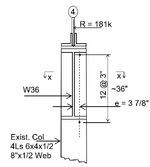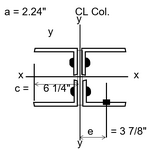raystr2025
Structural
- Feb 26, 2025
- 4
Hello, I am looking for help in trying to figure out how to analyze the effect of the eccentric load on the rivets of a built-up section.
If you are able to see below, on the left side of the W36 beam there is a large room which cannot be disturbed. To strengthen the built-up girder that is resting on the existing built-up column, I introduced a W36 beam underneath to share in the transfer of the load on the structure from above (181 kips). The connection is to one flange of the built-up column with an e= 3.875 in. Through the calculations, it is introducing fb = 1.43 ksi.
A comment was made to provide documentation that the rivets in the existing built-up column (7/8" diameter, 5" center to center, column is 17 ft tall) would be able to take the eccentric load.
I have been thinking about it all day, and I am not sure how to prove this - would I have to use something like RAM/ Idea Statica? Any guidance would be very helpful!


If you are able to see below, on the left side of the W36 beam there is a large room which cannot be disturbed. To strengthen the built-up girder that is resting on the existing built-up column, I introduced a W36 beam underneath to share in the transfer of the load on the structure from above (181 kips). The connection is to one flange of the built-up column with an e= 3.875 in. Through the calculations, it is introducing fb = 1.43 ksi.
A comment was made to provide documentation that the rivets in the existing built-up column (7/8" diameter, 5" center to center, column is 17 ft tall) would be able to take the eccentric load.
I have been thinking about it all day, and I am not sure how to prove this - would I have to use something like RAM/ Idea Statica? Any guidance would be very helpful!


